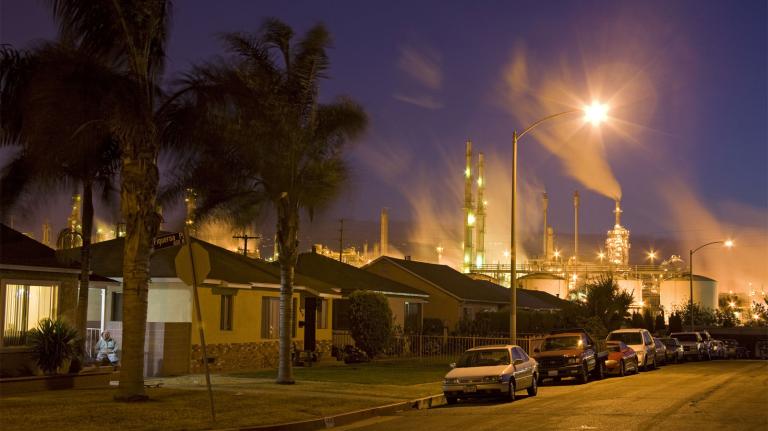Over the summer of 2020, Adrienne Sandoval, New Mexico’s top oil and gas regulator, testified before a U.S. House of Representatives energy subcommittee that was looking into abandoned oil and gas wells. Oil prices had plummeted in the first few months of the pandemic, thousands of fossil fuel workers had filed for unemployment, and operators were facing dire financial straits. It appeared that many companies would walk away from their responsibility to plug their defunct oil and gas wells, leaving the state responsible for the hazards and pollution they leave behind.
“While New Mexico has 708 known orphaned wells, there is risk for many more during this downturn,” she said. “Additional funding would allow New Mexico to more rapidly plug abandoned wells and reclaim sites to minimize environmental disturbance.”
Sandoval’s testimony was part of a larger push by New Mexico’s congressional delegation to secure funds to clean up the state’s backlog of so-called “orphan” oil and gas wells. The problem is hardly limited to New Mexico: Nationwide, the Environmental Protection Agency estimates there are 3.1 million orphan wells that are leaking the equivalent of 7.1 million metric tons of carbon dioxide — with a climate effect comparable to that of adding 1.5 million cars to the road for a year. Orphan wells have emerged as a bipartisan priority, and the effort ultimately culminated in $4.7 billion in funds for abandoned well cleanup in the infrastructure bill that Congress passed late last year.
As this funding was coming into view, states’ estimates of the scale of their orphan well problems began to balloon. For example, when the New Mexico Oil Conservation Division, or OCD, applied for a grant from the funding that it had pushed for, it cited a much larger figure than the 700 cited by Sandoval. Now the state claimed it had “1,741 known orphaned sites” that would cost more than $290 million to plug and clean up — well over twice the previous estimate. The reason for the uptick may be more banal and bureaucratic than opportunistic.
States have different definitions for when they consider a well to be officially abandoned or orphaned. Texas, for example, considers a well orphaned when it has not been producing oil and gas for at least 12 months and the responsible company has been delinquent in renewing its license for a year or longer. North Dakota regulators list a well as orphaned if its operator cannot be found, cannot be legally required to plug a well, or doesn’t have the funds to do so.
New Mexico — the second largest onshore oil producer and home to more than 59,000 producing wells — has no such criteria. If a well hasn’t been producing for 15 months, the OCD puts it on an inactive well list. More than 5,200 wells fall into this category, and this list serves as a master file for all enforcement actions that the agency pursues. If a company fails to plug a well after the agency serves it with an enforcement order, the well ends up on the state’s roster of wells it plans to plug itself. But the agency exercises discretion regarding which companies it chooses to file enforcement orders against, and the decision often comes down to a number of factors including the egregiousness of the violations and the resources the state has available to pursue a case.
On the basis of this subjective and selective method, the state considered about 700 wells to be orphaned prior to the infrastructure bill’s passing. Susan Torres, a spokesperson for the New Mexico oil and gas division, said that after the law’s enactment the state reviewed its roster and identified an additional 1,000 wells that are eligible for plugging, remediation, and reclamation. The federal funds to help with cleanup were a clear incentive for the state to do a full accounting of all its abandoned wells.
Indeed, the new count has led to a windfall for the state. Late last month, the Department of Interior announced that New Mexico would receive $43.7 million to clean up its orphan wells. The agency used a combination of the number of orphan wells, cost of cleanup, and number of jobs lost to arrive at the amount.
While it undoubtedly benefits New Mexico financially, the state’s new list of 1,741 orphan wells likely gets closer to a true estimate of the wells that will ultimately become taxpayers’ responsibility. Last year, Grist and the Texas Observer modeled the phenomenon of well abandonment in the Permian Basin, the massive shale formation that straddles Texas and New Mexico, and estimated that the two states are undercounting orphan wells to the extent that the number is set to triple in the coming years.
In New Mexico, our model identified 421 inactive wells that we predicted would be orphaned by operators within approximately four years. In reviewing the state’s new roster of orphans, we observed that 213 of the wells identified by our model have now made the list. In other words, half of the wells our model identified last year are now officially considered orphaned by the state. The state’s process appears to have mirrored our statistical approach: identifying wells that are indistinguishable from other orphans (and thus likely to meet the same fate). As was the case with our model’s predictions, the new orphan wells list mostly contains wells that only recently stopped producing oil and gas — a departure from previous official state lists.
There are other signs that New Mexico is using an approach very similar to ours. (You can read about our methodology here). To avoid biasing our original model, we did not train it on operator identification numbers and instead only fed in general operator characteristics, such as a producer’s state and business license type. However, in practice, a bankruptcy of an operator would imply the orphaning of all of its wells. Because our model was blind to which wells were managed by which operator, upon reviewing New Mexico’s new orphan wells list, we conducted a separate analysis of the model’s predictions that took well ownership into account. Doing so allowed us to be less statistically conservative in our estimates — and further test the hypothesis that wells recently added to New Mexico’s orphan well list shared characteristics with those predicted to be orphaned by our model.
Specifically, for every operator the model identified as likely to orphan at least one well, we forecasted the effect of these operators orphaning all of their wells. The resulting orphan list contains 1,516 wells. Of these, 713 already appear on New Mexico’s new list of orphan wells, suggesting that the state is taking similar information into account when flagging new orphan wells.
Torres said New Mexico’s orphan well count “may fluctuate over time” as more operators become insolvent or some wells resume production, but the current count is “the most likely universe of wells to be orphaned.” The state “has worked to nail down the most accurate number of inactive and orphan wells so New Mexico can ensure we get the proper funds to remediate these sites as part of the infrastructure package,” she said.




